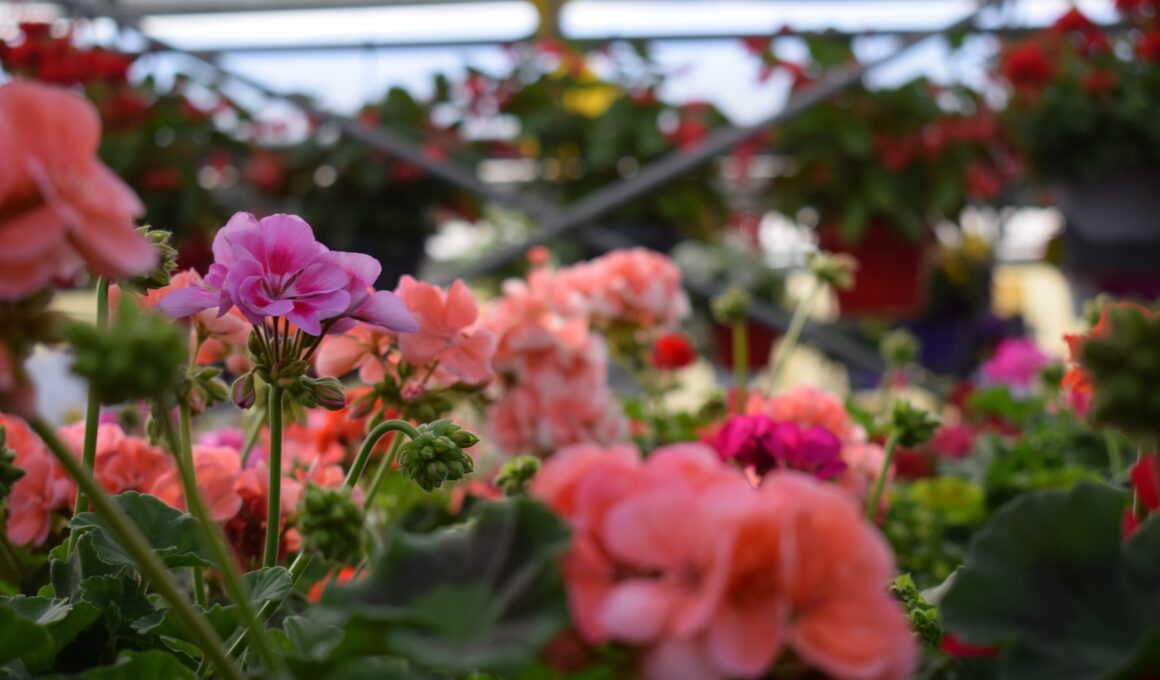Do you have geraniums in your garden that you’ve grown to love and care for? If so, you might be wondering if it’s worth the effort to overwinter them.
Overwintering geraniums involves bringing them inside during the colder months so they can survive until spring. While it may seem like a lot of work, there are benefits to overwintering geraniums that might make it worth your while.
One of the main benefits of overwintering geraniums is that it can save you money. Geraniums are a popular plant that are often used in outdoor containers and hanging baskets. If you have to buy new geraniums every year, it can add up quickly.
By overwintering your geraniums, you can save money and enjoy the same beautiful blooms year after year. Additionally, overwintering geraniums can help prevent the spread of disease. When you bring your geraniums inside, you’re removing them from the elements and reducing their exposure to pests and diseases.
This can help keep your plants healthy and thriving for years to come.
Understand the Benefits of Overwintering Geraniums
Discover the advantages of keeping your beloved garden plants alive and thriving through the cold winter months. Overwintering your geraniums can save you money in the long run since you won’t have to buy new plants every spring.
Plus, your geraniums will be healthier and stronger if you take care of them during the winter. By keeping them indoors or in a protected outdoor spot, you’ll be providing them with the warmth and shelter they need to survive.
There are alternatives to overwintering, such as discarding your geraniums and buying new ones every year. However, this can be expensive and wasteful. You can also try storing your geraniums in a dormant state, but this requires special equipment and knowledge.
Overwintering your geraniums is a simple and cost-effective solution that will keep your plants healthy and thriving. Incorporating overwintering into your gardening routine can bring you peace of mind.
Knowing that you’re taking care of your plants and keeping them healthy through the winter months can give you a sense of satisfaction and safety. So, don’t hesitate to give it a try and see the benefits for yourself.
Assess Your Climate and Growing Conditions
Before deciding whether to keep your geraniums alive through the winter, it’s important to assess the climate and growing conditions in your area.
One key factor to consider is plant hardiness. Geraniums are perennials that can survive in USDA hardiness zones 10 and 11. If you live in a colder climate, you may need to provide extra protection for your plants.
Another factor to consider is sunlight requirements. Geraniums prefer full sun, but they can tolerate partial shade. If you have limited sunlight in your area during the winter months, you may need to supplement with artificial light or move your plants to a sunnier location.
Overall, the decision to overwinter your geraniums will depend on your specific climate and growing conditions. If you live in a mild climate and have adequate sunlight, it may be worth the effort to keep your plants alive through the winter. However, if you live in a colder climate or have limited sunlight, it may be more practical to let your geraniums die back and start fresh in the spring.
What Are the Benefits of Overwintering Hostas in the Ground?
Leaving hostas in the ground for winter can have numerous benefits. Firstly, it provides insulation and protection to the plant’s root system against freezing temperatures. Additionally, this practice helps maintain the plant’s overall health and vigor. Overwintering hostas in the ground also reduces the risk of transplant shock and ensures earlier growth in the following spring.
Can I Expect Sage to Come Back Every Year Like Geraniums?
Can I expect sage’s annual return like geraniums? While geraniums are known for their predictable comeback each year, sage’s annual return may not be as consistent. Sage is a perennial herb, but its longevity and ability to survive the winter can vary depending on the specific variety and environmental conditions. So, while sage can indeed come back every year, it’s advisable to protect it during colder months to ensure its annual return.
Prepare Your Geraniums for Winter
To successfully prepare your geraniums for the winter season, you’ll need to take several steps to ensure their survival.
The first step is to prune your geraniums, which involves removing all the yellow or brown leaves, stems, and flowers. This will help your plants conserve energy and will reduce the risk of pests and diseases. You can use a sharp pair of scissors or pruning shears to cut back the stems to about half their length. Be sure to make clean cuts at a 45-degree angle to prevent water from settling on the cut surface.
The second step is to prepare the soil. Geraniums prefer well-draining soil that is rich in organic matter. You can improve the soil quality by adding compost, leaf mold, or peat moss. These materials will not only enrich the soil but also help retain moisture and prevent soil compaction.
After amending the soil, water your geraniums thoroughly to help settle the soil and ensure that the roots are well hydrated.
By following these pruning techniques and soil preparation tips, you can successfully prepare your geraniums for the winter season. Remember to keep your plants in a cool, dry, and well-ventilated area, away from direct sunlight and freezing temperatures.
With proper care, your geraniums can survive the winter and bloom again in the spring, bringing joy and color to your garden.
Choose the Right Storage Location
Make sure you choose a storage location that is cool, dry, and well-ventilated to ensure the survival of your beloved plants. Temperature control is crucial in overwintering geraniums. The ideal storage temperature range is between 45 to 50°F. Keep them away from direct heat sources and avoid areas that are prone to extreme temperature fluctuations.
Container options are also an important consideration when choosing the right storage location for your geraniums. You can choose between plastic bags, cardboard boxes, or pots. Whichever you choose, make sure it is clean and has drainage holes. Plastic bags are ideal for small plants, while pots are a great option for larger ones.
Place the containers in a location that receives natural light, and water them occasionally to prevent the soil from drying out.
Proper storage is key to overwintering geraniums successfully. By choosing the right storage location, you can help your plants survive the winter and thrive again come spring. Remember to monitor the temperature, choose the appropriate container, and keep them away from direct heat sources. With a little effort, you can enjoy your beautiful geraniums year after year.
Can Overwintering Geraniums Lead to Longevity?
Overwintering geraniums can lead to longevity, making them an ideal plant for 50 years. By properly caring for geraniums during the winter months, they can survive and thrive for decades, providing beautiful blooms and lush greenery year after year.
Care for Your Geraniums During Winter
When caring for your geraniums during the winter, it’s important to monitor for moisture and temperature to ensure they thrive. Make sure they’re not getting too much or too little water, and that the temperature in the room is consistent. Providing adequate light is also crucial, so consider using grow lights if necessary.
Lastly, check for pests and diseases regularly to catch any issues early and prevent them from spreading.
Monitor for Moisture and Temperature
You’ll want to keep a close eye on the moisture and temperature of your geraniums as they enter dormancy, ensuring that they’re neither too wet nor too dry and are kept in a cool but not freezing environment.
Watering frequency is crucial during this time, as overwatering can lead to root rot and under-watering can cause them to dry out. Aim to water your geraniums once a week, but adjust as needed based on the moisture levels of the soil.
In addition to monitoring watering frequency, it’s important to maintain the ideal temperature and humidity levels for your geraniums. Ideal temperature for dormancy is between 45 and 50 degrees Fahrenheit, so keep them in a cool location, but not in a freezing environment.
Humidity levels should be kept low to prevent mold and mildew from forming. By keeping a close eye on these factors, you’ll ensure that your geraniums stay healthy and ready to thrive come springtime.
Provide Adequate Light
It’s important to remember that providing adequate light during dormancy is crucial for healthy spring growth of your overwintered geraniums. While these plants are designed to go dormant during the winter months, they still need some light to keep them healthy.
Indoor lighting can help you achieve this goal. Place your geraniums near a south-facing window or under a grow light for 8-10 hours per day. If you’re using a grow light, make sure to keep it about 6 inches away from the plants to prevent burning.
Another way to ensure healthy spring growth is by using pruning techniques during dormancy. Pruning your geraniums will help promote new growth and keep them healthy. Cut back any dead or diseased leaves and stems, and trim the remaining foliage to about one-third of its original size. This will help the plant conserve energy and focus on producing new growth in the spring.
By providing adequate light and using pruning techniques, you’ll be well on your way to successfully overwintering your geraniums and enjoying beautiful blooms come springtime.
Check for Pests and Diseases
Before bringing your geraniums inside for the winter, make sure to check them for any pests or diseases that could harm the plant’s health during dormancy. Prevention methods are key to avoiding any potential problems.
To prevent pests, regularly inspect the leaves and stems for any signs of infestation. Common pests that can attack geraniums include spider mites, aphids, and whiteflies. If you notice any of these pests, treat the plant with insecticidal soap or neem oil.
In addition to pests, geraniums can also be susceptible to plant diseases. Common diseases include fungal infections such as powdery mildew and botrytis. To prevent these diseases, make sure the plant has good air circulation and avoid over-watering. If you notice any signs of disease, such as discolored or wilting leaves, treat the plant with a fungicide.
By checking for pests and diseases before bringing your geraniums inside, you can ensure the health of your plant during the winter months.
Frequently Asked Questions
How do I know if my geraniums are suitable for overwintering?
To determine if your geraniums are suitable for overwintering, take a closer look at their current state. Are the plants healthy and disease-free? Have they been thriving in their current environment? If so, then it’s likely that your geraniums are good candidates for overwintering.
Geranium care during winter involves providing them with enough light, humidity, and warmth. You can either bring them indoors or keep them outside in a sheltered area. Prune the plants back by a third to promote healthy growth in the spring.
Remember that winter plant care is crucial for the survival of your geraniums, so take the necessary steps to ensure their well-being.
Can I overwinter geraniums in a heated garage or shed?
If you’re considering overwintering your geraniums, a heated garage is a great option for keeping your plants alive and healthy during the colder months. This option provides a controlled environment that can protect your plants from extreme weather conditions while still allowing them to receive sunlight.
However, if you prefer outdoor overwintering techniques, you can bury your geraniums in the soil or cover them with a thick layer of mulch. This method can shield your plants from harsh winter conditions and help them survive until spring.
Overall, whether you choose a heated garage or outdoor overwintering, both options can help your geraniums survive the winter and thrive in the spring.
What kind of fertilizer should I use on my overwintered geraniums?
When it comes to fertilizing your overwintered geraniums, there are some organic options that you can consider.
One option is to use a slow-release fertilizer, which will slowly release nutrients over time and provide your plants with a steady food supply.
Another option is to use a liquid organic fertilizer, which can be applied directly to the soil or sprayed onto the leaves.
Timing considerations are important when it comes to fertilizing your geraniums. You should avoid fertilizing them during the winter months when they’re not actively growing, as this can cause the plants to become stressed.
Instead, wait until the spring when the plants are starting to grow again before applying fertilizer.
By using organic options and being mindful of timing considerations, you can help ensure that your overwintered geraniums stay healthy and vibrant.
Is it necessary to prune my geraniums before overwintering them?
To ensure your geraniums survive the winter, it’s important to give them proper care. One essential step in their winter care is pruning.
Pruning benefits your geraniums by promoting healthy growth and preventing disease. Before overwintering your geraniums, it’s best to remove any dead or damaged stems and leaves. This will improve air circulation around the plant and reduce the risk of fungal infections.
Pruning also helps to keep the plant compact and promotes more blooms in the spring. So, make sure to give your geraniums a good pruning before tucking them in for the winter.
Can I propagate my geraniums while they are overwintering?
Looking to propagate your geraniums while they’re overwintering? You’re in luck!
Propagation tips suggest that the best time to do so is during the winter months. You’ll want to take stem cuttings from the mother plant, making sure they have at least two nodes and a few leaves.
Then, dip the cuttings in rooting hormone and place them in a well-draining potting mix. Keep the soil moist and the plant in a warm, bright location.
In a few weeks, you should start to see roots forming. With these propagation tips, you can easily expand your geranium collection while keeping your overwintered plants safe and sound.
Conclusion
So, is it worth overwintering geraniums? Yes, it is! Overwintering your geraniums can save you money and time in the long run, as well as allow you to keep cherished plants for multiple growing seasons.
By following the steps outlined in this article, you can successfully overwinter your geraniums and ensure they thrive come springtime. Remember to assess your climate and growing conditions, prepare your geraniums for winter, choose the right storage location, and care for them during the winter months.
With a little effort and attention, you can enjoy beautiful geranium blooms year after year.









